KOREA 11th Airborne Officers Paratrooper KOREAN War African American collection
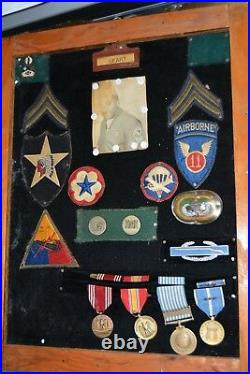
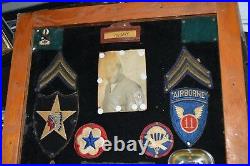
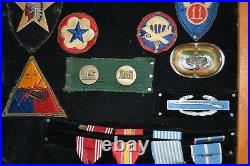
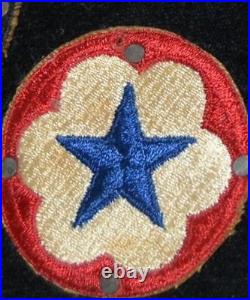
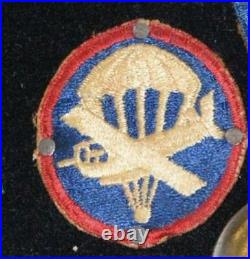
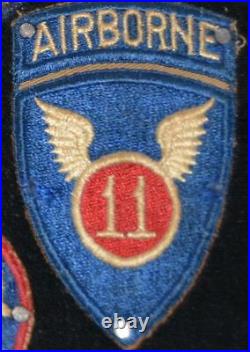
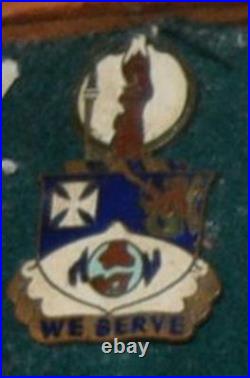
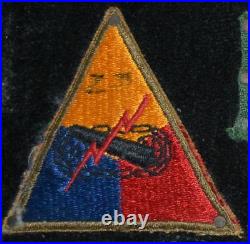

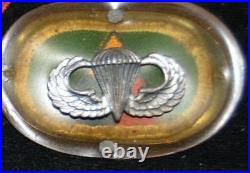
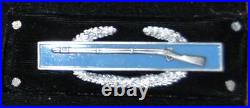
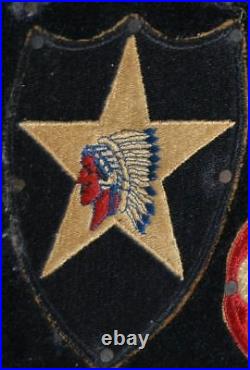

A rare collection of framed material from African American Officer/Corporal Geary from the Korean War. Features many patches and medals from his service as well as a photo of him in uniform. Framed without glass (needs cleaning) 16" X 20" inches overall.
Army 2nd infantry Division, U. Army Service, Paratrooper insignia US Combine, Airborne Cap patch, 11th Airborne Division patch, Armored Division (missing #), Pacific Paratrooper, and many more items (see pics). E 11th Airborne Division was activated at Camp Mackall North Carolina on February 25, 1943 under the command of Major General Joseph M.
The division was manned primarily with former glider troops and some veteran Airborne troops. Immediately after activation, the Division began an intensive training cycle to get all of the glider troops jump qualified. Many of the troops were simply sent up in an aircraft with little formal training on the ground. The new Airborne soldiers performed above expectations and the Division was ready for overseas movement barely a year later. In early 1944, the "Angels" were ordered to prepare for embarkation and the Division moved to San Francisco California.They boarded troop transports and in May they were on their way to New Guinea in the South Pacific. Upon arrival they were ordered into an intensive training cycle to learn jungle warfare in preparation for the invasion of the Pilippines.
For 5 months the 11th Airborne sweated in the jungles and mountains of New Guinea and had several training jumps. FInally on November 11th, the Division boarded transports for their objective.
On November 18, 1944, the Angels landed at Leyte Beach Philippines. After consolidating their equipment, they moved inland to relieve they weary 24th Infantry and 37th Infantry Divisions. The 11th's objective was to clear a mountain pass from Burauen to Ormoc. It took 3 months of bitter fighting, often hand-to-hand to drive the Japanese defenders from the pass and surrounding heights. In the end the 11th Airborne had killed almost 6,000 enemy soldiers. When the Division arrived in Ormoc they were given a much needed rest and resupply. On January 26, 1945 the 11th went back into action having rested only a few days. The Division landed at Nasgubu Beach, Luzon some 70 miles from the capitol city of Manila.Their mission was simple, clear all enemy opposition from a major highway and link up with the Allied forces attacking Manila. In just 5 days, the Division had eliminated all enemy resistance along Highway 17 and had pierced the main line of resistance at Tagayatay Ridge. Here the 511th Parachute Infantry Regiment conducted a combat parachute drop to reinforce the 11th and the Division continued north. After capturing Fort McKinley and Nichols field, the 11th launched their assult on Manila joining the 1st Cavalry Division and the 37th Infantry Division who were attacking from the North.
Once the capitol was liberated, the 11th made a daring raid behind enemy lines and liberated 2,147 Allied POWs from the Los Baños Internment Camp. Once that mission was cleared the 11th Airborne spent the next few weeks mopping up resistance in the southern areas of Luzon.In May of 1945, the Division moved into a reserve area in the Philippines to rest, resupply and take in new troops. They began preparations for the next big operation. Operation Olympic, the invasion of the Japanese home islands. Those plans were cancelled after the Japanese surrender in August 1945. 10, 1945, the division moved to Okinawa to escort Gen.
Douglas MacArthur into Japan and to spearhead the occupation. The 11th Airborne landed at Atsugi Airdrome, near Tokyo, on Aug.
30, 1945, and occupied an initial area in and around Yokohama. They remained there until mid-September 1945, when they moved to northern Japan and assumed responsibility for Akita, Yamagata, Miyagi and Iwate Prefectures. The division later took over control of Amori, Hokkaido, Fukushima and Prefectures to control of almost half the island of Honshu and all the island of Hokkaido. Legend has it that when the 1st Cavalry Division, whose motto is "1st in Manila, 1st in Tokyo" arrived in Tokyo, they were met by the 11th Airborne Division band. The band played a special song for the Cavalry; "The old gray mare ain't what she used to be".
General Swing left the division, which he had formed and led through combat, in January 1948, to assume command of 1st Corps, 8th Army and Maj. Miley, the former commander of the 17th Airborne Division, assumed command. The 11th Airborne Division remained on occupation duty until 1949 when they were relieved and sent to Camp Campbell Kentucky. The 11th Airborne Division ("Angels"[1]) was a United States Army airborne formation, first activated on 25 February 1943, during World War II. Consisting of one parachute and two glider infantry regiments, with supporting troops, the division underwent rigorous training throughout 1943. It played a vital role in the successful Knollwood Maneuver, which was organized to determine the viability of large-scale American airborne formations after their utility had been called into question following a disappointing performance during the Allied invasion of Sicily. Held in reserve in the United States for the first half of 1944, in June the division was transferred to the Pacific Theater of Operations.Upon arrival it entered a period of intense training and acclimatization, and by November was judged combat-ready. The 11th Airborne saw its first action on the island of Leyte in the Philippines, but in a traditional infantry role.
In January 1945 the division took part in the invasion of Luzon. The two glider infantry regiments again operated as conventional infantry, securing a beachhead before fighting their way inland.The parachute infantry regiment was held in reserve for several days before conducting the division's first airborne operation, a combat drop on the Tagaytay Ridge. Reunited, the division participated in the Liberation of Manila, and two companies of divisional paratroopers conducted an audacious raid on the Los Baños internment camp, liberating two thousand civilians. The 11th Airborne's last combat operation of World War II was in the north of Luzon around Aparri, in aid of combined American and Philippine forces who were battling to subdue the remaining Japanese resistance on the island.
On 30 August 1945 the division was sent to southern Japan as part of the occupation force. Four years later it was recalled to the United States, where it became a training formation. One parachute infantry regiment was detached for service in the Korean War, but on 30 June 1958 the division was inactivated. It was briefly reactivated on 1 February 1963 as the 11th Air Assault Division (Test) to explore the theory and practicality of helicopter assault tactics, and was inactivated on 29 June 1965. The division's personnel and equipment were transferred to the newly raised 1st Cavalry Division (Airmobile). Reactivation (11th Air Assault Division) and inactivation. Inspired by the pioneering German use of large-scale airborne formations during the Battle of France in 1940 and later the invasion of Crete in 1941, [3] the various Allied powers decided to raise airborne units of their own.[4] One of the resultant five American and two British airborne divisions, [5][6] the 11th Airborne Division, was officially activated on 25 February 1943 at Camp Mackall in North Carolina, under the command of Major General Joseph Swing. As formed the division consisted of the 511th Parachute Infantry Regiment, the 187th Glider Infantry Regiment and the 188th Glider Infantry Regiment, and with a complement of 8,321 men was around half the strength of a regular U.
Infantry division of World War II. Swing, commander of the 11th Airborne Division during World War II. The division initially remained in the United States for training, which in common with all airborne units was extremely arduous to befit their elite status. [8] Training included lengthy forced marches, simulated parachute landings from 34-and-250-foot (10 and 76 m) towers, and practice jumps from transport aircraft; hesitancy in the doorway of an aircraft resulted in an automatic failure for the candidate. The washout rate was high, but there was never a shortage of candidates, especially because in American airborne units the rate of pay was much higher than that of an ordinary infantryman.Before training was complete a debate developed in the U. Army over whether the best use of airborne forces was en masse or as small, compact units. On 9 July 1943, the first large-scale Allied airborne operation was carried out by elements of the U. 82nd Airborne Division and the British 1st Airborne Division in support of the Allied invasion of Sicily, code-named Operation Husky.
[9] The 11th Airborne Division's commanding general, Major General Swing, was temporarily transferred to act as airborne advisor to General Dwight D. Eisenhower for the operation, and observed the airborne assault which went badly. The 82nd Airborne Division had been inserted by parachute and glider and had suffered high casualties, leading to a perception that it had failed to achieve many of its objectives. Eisenhower reviewed the airborne role in Operation Husky and concluded that large-scale formations were too difficult to control in combat to be practical.
[11] Lieutenant General Leslie J. McNair, the overall commander of Army Ground Forces, had similar misgivings: once an airborne supporter, he had been greatly disappointed by the performance of airborne units in North Africa and more recently Sicily. However, other high-ranking officers, including the Army Chief of Staff George Marshall, believed otherwise. Marshall persuaded Eisenhower to set up a review board and to withhold judgement until the outcome of a large-scale maneuver, planned for December 1943, could be assessed.[13] McNair ordered him to form a committeethe Swing Boardcomposed of air force, parachute, glider infantry, and artillery officers, whose arrangements for the maneuver would effectively decide the fate of divisional-sized airborne forces. [10] As the 11th Airborne Division was in reserve in the United States and had not yet been earmarked for combat, the Swing Board selected it as the test formation.
The maneuver would additionally provide the 11th Airborne and its individual units with further training, as had occurred several months previously in an earlier large-scale exercise conducted by the 101st and the 82nd Airborne Divisions. I do not believe in the airborne division. I believe that airborne troops should be reorganized in self-contained units, comprising infantry, artillery, and special services, all about the strength of a regimental combat team... To employ at any time and place a whole division would require a dropping over such an extended area that I seriously doubt that a division commander could regain control and operate the scattered forces as one unit.
The conclusion of General Eisenhower's review of the performance of American airborne forces during Operation Husky[10]. The 11th Airborne, as the attacking force, was assigned the objective of capturing Knollwood Army Auxiliary Airfield near Fort Bragg in North Carolina. [15] The force defending the airfield and its environs was a combat team composed of elements of the 17th Airborne Division and a battalion from the 541st Parachute Infantry Regiment. [16] The entire operation was observed by Army Ground Forces commander Lt. McNair, who would ultimately have a significant say in deciding the fate of the parachute infantry divisions.The Knollwood Maneuver took place on the night of 7 December 1943, with the 11th Airborne Division being airlifted to thirteen separate objectives by 200 C-47 Skytrain transport aircraft and 234 Waco CG-4A gliders. [18] The transport aircraft were divided into four groups, two of which carried paratroopers while the other two towed gliders.
Each group took off from a different airfield in the Carolinas. The four groups deployed a total of 4,800 troops in the first wave. Eighty-five percent were delivered to their targets without navigational error, [18] and the airborne troops seized the Knollwood Army Auxiliary Airfield and secured the landing area for the rest of the division before daylight. [18] With its initial objectives taken, the 11th Airborne Division then launched a coordinated ground attack against a reinforced infantry regiment and conducted several aerial resupply and casualty evacuation missions in coordination with United States Army Air Forces transport aircraft. [18] The exercise was judged by observers to be a great success. McNair, pleased by its results, attributed this success to the great improvements in airborne training that had been implemented in the months following Operation Husky. As a result of the Knollwood Maneuver, division-sized airborne forces were deemed to be feasible, and Eisenhower permitted their retention. Main article: Battle of Leyte. Following the Knollwood Maneuver the 11th Airborne remained in reserve until January 1944, when it was moved by train from Camp Mackall to Camp Polk in Louisiana. After four weeks of final preparation for its combat role, [20] in April the division was moved to Camp Stoneman, California, and then transferred to Milne Bay, Papua New Guinea, between 25 May and 11 June. [20] From June to September the division underwent acclimatization and continued its airborne training, conducting parachute drops in the New Guinea jungle and around the airfield in Dobodura. During this period, most of the glider troops became parachute-qualified making the division almost fully Airborne. On 11 November the division boarded a convoy of naval transports and was escorted to Leyte in the Philippines, arriving on 18 November. [21] Four days later it was attached to XXIV Corps and committed to combat, but operating as an infantry division rather than in an airborne capacity. The 11th Airborne was ordered to relieve the 7th Infantry Division stationed in the Burauen-La Paz-Bugho area, engage and destroy all Japanese forces in its operational area, and protect XXIV Corps rear-area supply dumps and airfields. Map of the Philippines with Leyte highlighted. Swing ordered the 187th Glider Infantry Regiment (GIR) to guard the rear installations of XXIV Corps, while the 188th GIR was to secure the division's rear and conduct aggressive patrols to eliminate any enemy troops in the area. The 511th Parachute Infantry Regiment (PIR) was assigned the task of destroying all Japanese formations in the division's operational area, which it began on 28 November when it relieved the 7th Infantry.The 511th PIR advanced overland with two battalions abreast and the third in reserve, [23] but progress proved slow in the face of fierce Japanese resistance, a lack of mapped trails, and heavy rainfall with more than twenty-three inches (60 cm) falling in November alone. As the advance continued resupply became progressively more difficult; the division resorted to using large numbers of Piper Cub aircraft to drop food and ammunition. [24] Several attempts were made to improve the rate of advance, such as dropping platoons of the 187th GIR from Piper Cubs in front of the 511th PIR to reconnoiter, and using C-47 transport aircraft to drop artillery pieces to the regiment's location when other forms of transport, such as mule-trains, failed. Troops of the 511th Parachute Infantry Regiment evacuate a wounded soldier to an aid station at Manarawat on the island of Leyte, December 1944.
On 6 December the Japanese tried to disrupt operations on Leyte by conducting two small-scale airborne raids. The first attempted to deploy a small number of Japanese airborne troops to occupy several key American-held airfields at Tacloban and Dulag, but failed when the three aircraft used were either shot-down, crash-landed or destroyed on the ground along with their passengers.
[26] The second, larger, raid was carried out by between twenty-nine and thirty-nine transport aircraft supported by fighters; despite heavy losses, the Japanese managed to drop a number of airborne troops around Burauen airfield, where the headquarters of 11th Airborne Division were located. [27][28] Five L-5 Sentinel reconnaissance aircraft and one C-47 transport were destroyed, but the raiders were eliminated by an ad hoc combat group of artillerymen, engineers and support troops led by Maj.
The 511th PIR was reinforced by the 2nd Battalion, 187th GIR, and continued its slow but steady progress. On 17 December it broke through the Japanese lines and arrived at the western shoreline of Leyte, linking up with elements of the 32nd Infantry Division. [30] It was during this period that Private Elmer E. Fryar earned a posthumous Medal of Honor when he helped to repel a counterattack, personally killing twenty-seven Japanese soldiers before being mortally wounded by a sniper.[31] The regiment was ordered to set up temporary defensive positions before being relieved on 25 December by the 1st Batt. 187th GIR, and the 2nd Batt.
188th GIR, who would themselves incur considerable casualties against a heavily dug-in enemy. The 511th PIR was reassembled at its original base-camp in Leyte on 15 January 1945. Main article: Battle of Luzon. Map of the Philippines showing the island groups of Luzon, Visayas, and Mindanao. On 22 January the division was placed on alert for an operation on the island of Luzon, to the north of Leyte.
[29] Five days later the 187th and 188th Glider Infantry Regiments were embarked for Luzon by sea, while the 511th Parachute Infantry Regiment flew by C-46 Commando transport aircraft to Mindoro. At dawn on 31 January the 188th GIR led an amphibious assault near Nasugbu, in southern Luzon. Supported by a short naval barrage, A-20 Havoc light bombers and P-38 Lightning fighter aircraft, a beach-head was established in the face of light Japanese resistance.
[33] The regiment moved rapidly to secure Nasugbu, after which its 1st Battalion advanced up the island's arterial Highway 17 to deny the Japanese time to establish defenses further inland. The 2nd Battalion moved south, crossing the River Lian and securing the division's right flank. [34] By 10:30 elements of the 188th had pushed deep into southern Luzon, creating the space for the 187th GIR to come ashore. The 188th's 2nd Battalion was relieved and the regiment continued its advance, reaching the River Palico by 14:30 and securing a vital bridge before it could be destroyed by Japanese combat engineers.Troops of the 188th Glider Infantry Regiment make their way through the town of Nasugbu on the island of Luzon, 31 January 1945. Following Highway 17 to Tumalin, the regiment began to encounter heavier Japanese resistance. [35] At midnight the 187th took over the lead and the two glider infantry regiments rested briefly before tackling the main Japanese defensive lines. These consisted of trenches linked to bunkers and fortified caves, and were manned by several hundred infantry with numerous artillery pieces in support. [36] At 09:00 on 1 February the glider infantry launched their assault, and by midday had managed to break through the first Japanese position; they spent the rest of the day conducting mopping up operations.
On the morning of 2 February the second line was breached, and by midnight the 188th had broken a third. The divisional reconnaissance platoon was now in the vicinity of Tagaytay Ridge, the intended site of the 511th Parachute Infantry Regiment's first combat drop. The 511th's airborne operation had originally been scheduled for 2 February, but with Major General Swing's insistence that the drop was only to go ahead if his ground forces were in range to offer support, the dogged Japanese resistance encountered delayed the operation. [37] With only forty-eight C-47 Skytrain transport aircraft available, the 511th was forced to deploy in three waves.
The regimental staff, the 2nd Battalion and half of the 3rd Battalion would drop first, the rest of the regiment would arrive in the second lift, and the 457th Parachute Field Artillery Battalion would drop in the third. Paratroopers of the 511th Parachute Infantry Regiment prepare for their combat jump on Tagaytay Ridge, 3 February 1945. At 03:00 on 3 February the troops of the first lift entered their transport planes, and at 07:00 the first transports left Mindoro.
Protected by an escort of P-61 Black Widow night fighters, on arriving over Luzon they followed Highway 17 to Tagaytay Ridge. The ridge itself was an open space some two thousand yards (1,800 m) long and four thousand yards (3,700 m) wide, plowed in places, and had been largely cleared of Japanese troops by local Filipino soldiers and recognized guerrillas. [38] At 08:15 the first echelon of the first lift, approximately 345 men, successfully parachuted into the drop zone. The second echelon, consisting of approximately 570 men, were dropped prematurely and landed about eight thousand yards (7,300 m) to the east.
The next lift also encountered problems, with 425 men dropping correctly but another 1,325 dropping early due to pilot error and poor jump discipline. [39] However, the entire regiment was assembled within five hours of the first landings. [40] After overcoming minor Japanese resistance, by 15:00 the 511th had made contact with the 188th and 187th, and the entire division was once again assembled as a single formation. The ridge having been cleared of its remaining defenders, the division began to advance towards Manila, reaching the Paranaque River by 21:00.The city was protected by the Genko Line, a major Japanese defensive belt that stretched along Manila's southern edge. [41] The line consisted of approximately 1,200 two- to three-story deep blockhouses, many of which emplaced naval guns or large-caliber mortars.
Entrenched heavy anti-aircraft weapons, machine-gun nests and booby-traps made of naval bombs completed the defenses, which were manned by around 6,000 Japanese soldiers. The 11th Airborne Division was ordered to breach the Genko Line and drive into Manila, where it would link up with other American forces attacking the city from the north. All three regiments were committed to the assault. [43] Spearheading the division's attack on 5 February, the 511th overcame fierce resistance and broke the crust of the Japanese position, but was soon relieved by the 188th.
As the glider regiment took up the push westwards in the face of heavy opposition, the 511th changed their axis of advance and attempted to move into the city from the north. By 11 February, the division had penetrated as far as Nichols Field, an airfield that formed the center of the Genko Line.
This was heavily fortified with a number of entrenched naval guns and a series of bunkers; after a short artillery bombardment on the morning of 12 February, the 187th's 2nd Battalion attacked the airfield's north-west corner while the 1st Battalion and the entire 188th regiment moved in from the south and south-eastern corners. This pincer movement succeeded in taking the airfield and, despite a local counter-attack, by nightfall the position was secured. [44] The following day the division thrust towards Fort William McKinley, the headquarters of Rear Admiral Iwabuchi, commander of the Japanese defenders on Luzon. It was during this advance that Private First Class Manuel Perez Jr.Neutralized several Japanese bunkers which were impeding the division's progress, capturing one single-handedly and killing eighteen Japanese soldiers. PFC Perez was posthumously awarded the Medal of Honor. On 15 February, the 1st Battalion of the 187th, alongside other American units, launched an attack on Mabato Point. This was an extremely heavily fortified position featuring the same defensive measures as the Genko Line, and it would take six days of hard fighting, multiple airstrikes, and the frequent use of napalm and heavy artillery, before the point was secured. [46] Meanwhile, having taken heavy casualties on its approach to Fort McKinleyparticularly when the Japanese detonated a quantity of buried naval depth chargeson 17 February the rest of the 11th Airborne Division assaulted the fort.
The 511th led the break-in, and by 18 February the area had been cleared of its defenders. [47] Sporadic fighting continued in Manilla until 3 March, when all organized Japanese resistance ended.
Main article: Raid at Los Baños. A large number of civilian prisoners had been detained by the Japanese on Luzon, mostly in internment camps scattered throughout the island. The largest of these was located on the campus of the Agricultural College of the Philippines at Los Baños, some forty miles (64 km) south-east of Manila.[48] General Douglas MacArthur had tasked the 11th Airborne Division with rescuing the Los Baños internees on 3 February, but the division's ongoing combat operations around the Genko Line left it unable to divert any resources at that time. [49] All that could be accomplished during February was to gather information, primarily through liaison with the guerilla groups operating in Southern Luzon and around Los Baños.
Swing and his command staff were briefed daily by the officer working with the guerilla groups, Major Vanderpool. [49] From the guerillas and a few civilians that had escaped the camp, Vanderpool established that it was surrounded by two barbed-wire fences approximately six feet tall. Several guard towers and bunkers dotted its perimeter, each containing at least two guards.
Prisoners left each morning under armed guard to gather food supplies and firewood from a nearby town. [50] Vanderpool was informed that the camp's population consisted of American civilians in three distinct groups: Protestant missionaries and their families; Roman Catholic nuns and priests; and professional workers such as doctors and engineers, and their families. The latter group included several hundred women and children. While all the inmates appeared to be in good health, many had become weak from food rationing. Swing was finally able to release sufficient troops for a raid on the Los Baños camp, and a four-phase plan was devised by Major Vanderpool and the divisional staff officers.
[52] The divisional reconnaissance platoon would travel across a nearby lake and move to the outskirts of the camp, securing a large adjacent field as the drop zone for a company of paratroopers. Having landed, the paratroopers would eliminate Japanese resistance in the area, secure the camp, and prepare for its evacuation. Fifty-four amphibious Amtracs would transport two additional companies of paratroopers to the lake shore, where a beachhead would be established while the Amtracs continued to the camp to evacuate its occupants. Simultaneously, a task force consisting of a reinforced infantry battalion, two battalions of heavy artillery and a tank destroyer battalion would advance down Highway 1 towards Los Baños to interdict any Japanese attempts to interfere.Los Baños internees with 11th Airborne paratroopers after the raid, 23 February 1945. Assisted by a group of guerrillas, on the night of 21 February the divisional reconnaissance platoon made their way to the lake and collected ten canoes. Despite navigational difficulties, the platoon came ashore near Los Baños at 02:00 the following morning, and after securing the paratroopers' drop zone, concealed themselves in the jungle near the camp.
[53] During the afternoon B Company of the 1st Battalion, 511th PIR was transferred to the airfield from which they would be deployed, while the rest of the battalion rendezvoused with the Amtrac convoy. [54] At 07:00 on the morning of 23 February, B Company took off in ten C-47 Skytrain transport aircraft, arriving over their drop zone shortly afterwards.[54] As the first paratroopers landed, the reconnaissance platoon and the supporting guerilla fighters opened fire on the camp's defences, using Bazooka rounds to penetrate the concrete pillboxes, and then entered the camp to engage its garrison. The paratroopers soon joined the battle, and by 07:30 the Japanese guards had been overcome and the internees were being rounded up and readied for evacuation. [55] At the lakeshore the 511th's other two companies had secured their beachhead, and the convoy of Amtracs reached the camp without incident.
The first evacuation convoy left the camp at approximately 10:00, with B Company, the reconnaissance platoon and the guerrillas remaining behind to provide a rearguard. [56] Meanwhile, on Highway 1, the taskforce that had been deployed to protect the operation met heavy Japanese resistance and suffered several casualties, but was able to block Japanese forces that advanced on the camp, before retreating back to American lines. [57] The raid had been a complete success, liberating 2,147 civilians. On the day that the Los Baños internees were freed, the headquarters of Sixth United States Army assigned the 11th Airborne Division the task of destroying all Japanese formations in southern Luzon, south of Manila.
[59] The bulk of the division moved south the following day, with the 187th GIR and the 511th PIR advancing abreast. The 188th GIR was detached from the main advance by Maj. Swing; it was to eliminate all Japanese units still operating in the Pico de Loro hills along the southern shore of Manila Bay.
[59] These forces belonged to the 80,000-strong Shimbu Group, one of three groups of the Japanese Fourteenth Area Army under General Tomoyuki Yamashita. [60] It would take until the end of April for the 11th Airborne Divisionoften acting in conjunction with Filipino soldiers, the recognized guerillas and elements of the 1st Cavalry Divisionto subdue the Shimbu Group. Conducting combat operations was extremely difficult in the mountainous terrain, and many Japanese units elected to fight to the death rather than surrender. [59] However, all organized resistance in southern Luzon ended on 1 May, when the division captured Mount Malepunyo near the city of Lipa.The 11th Airborne established a base centered around the former Japanese airstrip on the outskirts of Lipa, the runway of which was lengthened by the 127th Airborne Engineer Battalion to accommodate C-47 transport aircraft. Once the engineering work was completed, the division's combat troops participated in several refresher-training courses. Map of Cagayan showing the location of Aparri.
The 11th Airborne's next operation took place on 23 June in the province of Aparri in northern Luzon. [62] By this time the only Japanese forces remaining on the island were positioned to the far north and belonged to the 52,000-strong Shobu Group. [62][63] This last of General Yamashita's three groups proved to be the most tenacious, forcing Lieutenant-General Walter Krueger, commander of the Sixth United States Army, to commit four infantry divisions, an armored task force, and a large band of the Filipino soldiers under the Philippine Commonwealth Army and Philippine Constabulary units and the recognized guerrillas. While these forces pinned down the Japanese, the 37th Infantry Division began an advance northwards, defeating a weaker formation and encircling the main Japanese force. To ensure the success of the 37th's drive, Krueger called for an airborne force to land near Aparri and move southwards to meet the advancing 37th.The 11th Airborne Division was to drop a battalion-sized combat team on Camalaniugan Airfield, approximately ten miles (16 km) south of Aparri. It would then advance southwards, eliminating all Japanese resistance, until it linked up with the leading elements of the 37th Infantry Division.
[65] To accomplish this Maj. Swing formed a special unitGypsy Task Forcecomprising the 1st Battalion of the 511th Parachute Infantry Regiment, G and I Companies of the regiment's 2nd Battalion, an artillery battery from the 457th Parachute Field Artillery Battalion, and a platoon of engineers and miscellaneous signal and medical detachments.
[66] Gypsy Task Force would be transported by fifty-four C-47 Skytrain and thirteen C-46 Commando aircraft, as well as six Waco CG-4A Gliders which would land jeeps and supplies for the task force. [67] On 21 June, a detachment of pathfinders from the division was flown in to secure Camalaniugan Airfield, and two days later the transport aircraft carrying the troops of Gypsy Task Force were escorted by fighters to the area. At 09:00 the pathfinder detachment set off colored smoke to mark the drop-zone, but fierce winds and uneven ground around the airfield proved hazardous to the parachutists, causing two deaths and seventy injuries during the drop. [68] Despite these casualties the force was rapidly concentrated, and began its advance southwards. Japanese resistance was stiff, forcing the airborne troops to rely on flamethrowers to eliminate bunkers and fortifications along their route. [68] After three days of fighting and having eliminated a significant portion of Shobu Group, the task force encountered the lead elements of the 37th Infantry Division. Although Shobu Group would continue its resistance until September, its encirclement marked the 11th Airborne Division's final combat operation of the war. Total battle casualties: 2,431[70].Killed in action: 494[70]. Died of wounds and injuries: 120[70]. Wounded in action: 1,926[70]. Missing in action: 11[70]. Main article: Occupation of Japan.
USAF C-54 Skymaster, of the type used to airlift the 11th Airborne Division into Japan. General MacArthur made plans to use the 11th Airborne Division in the invasion of Japan; it was to remain as Sixth Army's operational reserve, to be committed if required. [71] However, with the end of hostilities in the Pacific Theater due to the surrender of Japan, the division was instead selected by General MacArthur to lead the American forces that would occupy Japan. [72] The divisional staff received orders to this effect on 11 August 1945, [73] and the division was transported to Okinawa on 12 August; an operation that involved 99 B-24 Liberator bombers, 350 C-46 Commando and 150 C-47 Dakota transport aircraft to airlift 11,100 men, 120 vehicles and approximately 1.16 million pounds (530,000 kg) of equipment. [73] The 11th Airborne remained on Okinawa for several weeks before, [74] on 28 August, it was ordered to land at Atsugi Airfield outside of Yokohama, on the main Japanese home island of Honsh. Its instructions were to secure the surrounding area, evacuate all Japanese civilians and military personnel within a radius of three miles (4.8 km), and finally occupy Yokohama itself. [73] A large number of C-54 Skymaster transport aircraft were made available, with the firstcarrying Swing and his divisional stafflanding at Atsugi Airfield at 06:00 on 30 August. [73] It took a week to fully assemble the division, and by 13 September it had been joined by the 27th Infantry Division, which was airlifted into Japan at the same time. [75] The 11th Airborne Division was later moved from Yokohama to northern Japan, and established camps along the coast of Honshu and on the island of Hokkaido.[77] The division was transferred to Camp Campbell in Kentucky[77] and became a training formation, with several of its subordinate units inactivated including the 188th Glider Infantry Regiment. Training continued until the outbreak of the Korean War in 1950.
For service in Korea, the 187th Glider Infantry Regimentnow renamed the 187th Airborne Infantry Regimentand the 674th Airborne Field Artillery Battalion were detached from the division and re-formed as a separate Regimental Combat Team (RCT). [77] The 187th RCT saw two years of fighting in Korea, conducting two airborne operations as well as operating as conventional infantry. [78] The rest of the division continued its training role, processing and training approximately thirteen thousand recalled reservists between September and December 1950 alone. [77] The 187th RCT remained in Korea until 1 October 1953, when it was transferred to Japan for two years until being replaced by the 508th RCT. The 11th Airborne Division was sent to Germany in early 1956 as part of Operation Gyroscope, to replace the 5th Infantry Division stationed in Augsburg and Munich. As the division was en route, the 187th RCT was relocated to Fort Campbell, taking over the camps that the 11th had recently vacated. In July that year the 187th, along with the 508th ARC, was transferred to the newly reactivated 101st Airborne Division. As the American Army began to restructure its organization (known as the Pentomic Concept), the battalions of the 187th were re-designated as Airborne Battle Groups.In early 1957 the 1st Airborne Battle Group, 187th Infantry transferred to Augsburg to join its former parent formation, where it was reintegrated into the 11th Airborne Division. [80] The 2nd Airborne Battle Group, 187th Infantry remained with the 101st until 1964[81] while the 3rd Battalion was inactivated.
[82] However, the 11th Division was itself inactivated in Augsburg on 1 July 1958, and the 1st Airborne Battle Group was instead moved to the 24th Infantry Division. 11th Air Assault Division (Test) insignia.Air Cav (Airmobile) troopers, exiting from a "Huey" chopper, during stateside training. In the early 1960s, the United States Army began to explore alternative means for conducting future combat operations. One of the many ideas resulting from that effort was the concept of helicopter assault. To test this concept's feasibility, the 11th Airborne Division was reactivated on 1 February 1963 and renamed the 11th Air Assault Division (Test). [84] This was done on the recommendation of the U.
Army Tactical Mobility Requirements Board, also known as the'Howze Board' after its president Lieutenant General Hamilton H. The 11th never existed as a full division during the test period. Although the intent was to create three air assault brigades, the reality was an air assault brigade (which was also parachute-qualified), an airmobile brigade, and both ground and air artillery elements (the air artillery was provided by armed helicopters known as ARA).There was also an aviation group to control the helicopters assigned to the division -[86] the 11th Aviation Group, consisting of the 227th, 228th, and 229th Aviation Battalions. Elements of its original combat units the 187th Airborne Infantry, the 188th Airborne Infantry and the 511th Airborne Infantry were also reformed under the new division. For the next two years, the 11th Air Assault Division developed and refined air assault tactics and the equipment required to operate effectively in the role.
The 187th and 188th tested helicopters during various exercises, ranging from command and control maneuvers to scouting, screening and aerial resupply, to assess their ability to perform as combat aircraft. [88] However, the division was inactivated for the final time on 29 June 1965, with its personnel and equipment being merged with the 2nd Infantry Division to form the newly raised 1st Cavalry Division (Airmobile). The colors of the 1st Cavalry Division, at that time assigned to Korea, were transferred to Fort Benning, while those of the 2nd Infantry Division were moved to Korea.
11th Air Assault Division designation. An earlier predecessor to the current Air Assault Badge was worn by troops of 11th who qualified for it by making three helicopter rappels from 60 feet (18 m) and three from 120 feet (37 m). Soldiers were also required to be knowledgeable of aircraft safety procedures; familiar with aircraft orientation; proficient in hand and arm signals and combat assault operations; able to prepare, inspect and rig equipment for external sling loads; and able to lash down equipment inside helicopters. The badge was first awarded in early 1964 and was only authorized for wear by soldiers within the 11th. Rod Serling, former 11th Airborne Division paratrooper and creator of The Twilight Zone TV series.Lauri Törni, aka Major Larry Thorne, a former 11th Airborne Division soldier who was killed on a 1965 covert MACV-SOG mission in Vietnam. The Korean War (1950 to 1953) was the last American conflict involving segregated units of the arced forces, i.
3 American infantry divisions -- the 25th, the 2nd, and the 3rd -- contained black combat units during 1950/51. Among the 25th Division's 3 infantry regiments was the Army's last black 24th Infantry, the largest black unit to serve in Korea. The 24th Infantry was also the Army's only 3-bn regiment in action during initial weeks of the war. Other American regiments 1st committed to action from peacetime occupation duty in Japan contained only 2 bns.
Accompanied by the black 159th Field Arty bn and the black 77th Engineer Combat Co, the 24th Infantry arrived in the Korean Combat Zone beginning 7-13. On 7-20 the 24th's 3rd Bn, reinforced by a battery of the 159th and a platoon of the 77th, was the 1st 25th Division element to go into action at Yechon. In an extraordinary 2-day action hailed around the world as the US' initial Korean War victory, the reinforced bn drove the enemy from the town and recaptured it at a cost of 2 Americans killed and 10 wounded in action to at least 258 enemy dead. Subsequently, the 24th Regimental Combat Team.
Held the most vital part of the Pusan Perimeter Aug/Sep, taking and retaking Battle Mountain 19 times in 30 days. Led portions or 25th Division's breakout and advance westnorthward to the outskirts of Seoul mid-Sep. Advanced in North Korea to within a few miles of the Yalu River during late Nov, and then staged a fighting withdrawal as the Chinese entered the war astride the Chongehon River and in the vicinity of Kunuri. Crossed the Han River near Seoul with 2 other 25th Division regiments on 3-7-51 an important part of what UN Supreme Commander General Matthew B.Ridgway characterized years later as "the most successful single action fought by troops under my command during either World War II in Europe, or in Korea". Crossed the Hantan River northeast of Seoul alone 4-11 in the face of determined resistance from a superior enemy occupying the commanding terrain.
Stormed the heights above Mando and ejected the enemy from fortified positions with a bayonet charge and hand-to-hand fighting with hand grenades, mid-Sept 1951. During early Aug 1950, the 9th Infantry Regiment's black 3rd Bn and the black 503rd Field Arty Bn arrived in Korea with other 2nd Division elements. Initially, the black bn, a black arty battery, a tank company, and a company of engineers were detached and withheld front frontline action and assigned to guard an airfield near Pohang. In early Sep heavy combat losses among the 9th Inf's 2 white bns led to the assignment of some 200 black soldiers as individual replacements, a practice heartily endorsed by the regimental commander, Col. During mid-Sept, having been introduced gradually to combat action near Pohang and elsewhere, the 3rd Bn rejoined in time to strengthen the 9INF in attempting to break out from the Pusan Perimeter. During late Nov the last segregated 24th Division (on the right of the 25th Division) and the 1st integrating 9INF (on the left of the 2nd Division) advanced in northernmost North Korea side-by-side astride the Chongchon River. On 11-25, hit more heavily (than the 24th, the hardest hit of the 25th Division's regiments) by the Chinese, the 9INF fought extraordinarily well as 2 integrated and 1 segregated bn, the latter temporarily reinforced 2 nights running by 2 rifle companies separated from the 24th's fighting 2nd Bn. By the night of 11-29 the 9INF had been reduced to some 600 effectives as had its sister 38th Infantry. On the morning of 11-30, these 600, spearheading the 2nd Division's desperate attempt to withdraw south from Kunuri, surrounded by the enemy, were virtually wiped out and the 2nd Division was effectively destroyed.But a rebuilt 9Inf, thoroughly integrated, thereafter acquitted itself well in action after action during 1951. The 3rd infantry Division, complete with the black 3rd Bn, 15th Inf Regiment, disembarked at WonSan in northeast Korea in mid-Nov 1950, joining X Corps commanded by Major General Edward M.
Almond, notorious for his racist attitudes commanding the black 92d Infantry Division in Italy during WW2. The division included, in addition to the Puerto Rican 65th Infantry, the black 64th Tank Bn while the Corps-level black 58th and 999th Fields Arty Bns provided supporting firepower. After acquitting itself well in a defensive role during the evacuation of Hagaru and Hungnam, the 15th's 3rd Bn excelled in early Feb 1951, and on 5-19/20 at Pungnam. The performance of black arty, and armor bns in Korea was consistently superior.
The 25th Div's 159th Field Arty never lost a gun to the enemy, a record that few other 105-mm. The 77th Engineer Combat Company -- eventually the last black combat unit of the US Army ever to engage an enemy of the US -- was perhaps the most decorated single American unit in Korean War action. 2 of its officers, 2nd Lts.. Lenon, earned Distinguished Service Crosses during the initial weeks of the war, Benefield posthumously. 2 24th Infantrymen, Private 1st Class William Thompson and Sgt.
Charlton, posthumously were awarded the 1st Medals of Honor to black fighting men since Spanish-American War days (excepting, as of Apr 1991, the Medal of Honor awarded to a heroic WW1 black 371st infantryman). Another 24th infantryman, Corporal Levi A. Jackson, the US Army's heavyweight boxing champion, was posthumously awarded the Distinguished Service Cross.
Yet another Distinguished Service Cross wearer, 24th infantryman Sgt Curtis Pugh, is alive and well. The 77th Engineers' commander, 1st Lt. Charles M Bussey, was recommended for (but, apparently, wrongfully denied) both the Medal of Honor and the Distinguished Service Cross before having time enough in combat to be promoted to his WW2 rank of Capt.
Bussey, a fighter pilot in the pioneering black 332nd Fighter Group, flew 70 missions and scored 2 "kills", 2 probables, and 2 damaged enemy a/c in aerial combat. Another Distinguished Service Cross was awarded to 1Lt Ellison C.
Wynn who took command of the 9Inf's integrated B Company and led it heroically until he was seriously wounded during bitter fighting in late Nov 1950, astride the Chongchon River. No account of black combat units and heroes in Korea would be complete without mentioning the late Major Richard W. Williams, S-2, 24Inf, Regiment, who served during WW2 as a pioneering officer of the black 555th Parachute infantry Bn. Or of Capt Roger S. Walden, CO, Of Company, 24Inf, the 2d longest-serving rifle company commander in frontline action in Korea (who also served during World War II as a pioneering NCO of the black 555th Parachute infantry Bn) Or, finally, of the late 1Lt. Sutton, platoon leader, I Company, 15Inf, Silver Star at Hungnam' killed in action Feb, 1951, another pioneering black paratrooper. But the performance of some of these black combat units came into question, unjustly and unwarrantedly, during the war and afterward.The 24th Inf was accused, even by the late Army Chief of Staff General J. Layton Collins of "repeatedly breaking and running until the regiment was deactivated 10-1-1951" But the late General of the Army Omar N. Bradley's co-author of "A General's Story", Clay Blair, himself a distinguished military historian, has recently informed the Army chief of military history in personal correspondence that he knows that, had General Bradley known of the true facts concerning the 24th Infantry's Korean War outstanding service, he would have rewritten portions of his autobiography in tribute to these brave American soldiers.
In early Sep 1950, the 25th Infantry Division's commander, Major General William B. Kean, recommended to 8th Army Hqs that the 24INF be relieved of frontline combat service. This recommendation was ignored by the late General of the Army Douglas MacArthur and, subsequently, the record shows that the 24INF fought at least as well as other American regiments during the remainder of its last tour of duty until deactivated 10-1-1951. During 1951, back in the US, the 24th's famous CO, the late Brigadier General John T. Corley, sought to dispel others criticism by pointing out that in action "exceeding in roughness" anything he had witnessed in Europe 24th Infantrymen had fought as well as his own 1INF Division soldiers during WW2.But then-Col Corley was ordered to cease demonstrating his regard for his Korean War regiment by General Mark W. Clark because, reportedly, "some people in high places" were beginning to become alarmed. Among some factors worth noting concerning the 24Inf's initial weeks' commitment to Korean War action are. On his 1st day in Korea in Jul 1950, the original regimental executive officer feigned a heart attack and cowardly had himself medically evacuated. There was not a physically fit/professionally competent regimental commanding officer until LtCol Corley succeeded to command on 9-6.
During its 1st 3 months in action the 24INF experienced 13 changes (of which only 2 were casualty related) in bn commanders as compared to 1 and 3 changes, respectively, in the 25th Division's other i. It is interesting to note that none of these factors nor any of the 24th Regiment's outstanding combat successes has ever been officially recorded. But it has been recorded in the 1st of the Army's 3 volume official Korean War history covering the 1st 5 months of the war (including only the 1st 4 months of the 24th's 145-month Korean War service) that black 24th Infantrymen "broke and ran", "ran away from the enemy", "threw down their weapons", "withdrew without a fight", "broke ranks", repeatedly, whereas these terms are not used in reference to other i. E, white US regiments whose initial weeks' combat performance was no better. Curiously, although the 1st volume was publisher in 1961 and the 3d volume in 1966, the 2d volume was not published until 1990. How, then, could a separate official history, "Integration of the Armed Forces 1940-65", published in 1982, assert that the 24Inf's overall KW performance was "poor" and the proximate factor in the decision to begin integrating 8th Army in Korea? During 1988, responding to representations by then-Congressman Gus Hawkins (see Footnote #1) and House Armed Services Committee Chmn Les Aspin, Secretary of the Army John O. Chartered a special board of review to determine the truth about the 24th Infantry Regiment in Korea. In another year or so this board will render a report to Sec of the Army Michael P. Stone including an unprecedented official regimental- level history, the 24INF during 1950/51. It will be recalled that in 1972, Congressman Hawkins caused Pres Nixon to restore to the Army's honor rolls 165 black 25th Infantrymen who wrongfully had been discharged without honor following their alleged involvement in 1906 in the infamous "Brownsville (Texas) Incident", by which time only 2 of the soldiers remained alive. Hey signed up a lifetime ago, young men willing to serve their country even though their country did not serve them. They were told they were inferior: inferior humans, inferior soldiers, fit for peeling potatoes and sweeping barracks, shovelling coal and driving trucks, but not fighting.They were black negroes, in the eras parlance and the United States did not want them in foxholes alongside white soldiers. And it emphatically did not want them as paratroopers floating down from the sky.
Black guys would be too afraid to jump. Im not sure if I wanted to do it out of pride or to prove I could do it, says Wheeler Small, 85. If we failed it was as if we were going to be representing the whole of black society. Im not sure if I wanted to do it out of pride or to prove I could do it.
The surviving members of a small group of black soldiers that pierced segregation in the 1940s and 1950s, paving the way for a more integrated military and country, reunited last week to mark the milestone. The fearless young men are grandfathers and great-grandfathers now, some with canes, others in wheelchairs, and joked about pensions, creaking knees and medical prescriptions. Pride gleamed throughout the five-day gathering in Norfolk, Virginia. Pride that the Triple Nickles, as they are called, broke the race mould and blazed a trail for other African Americans, including Colin Powell, who rose to command the joint chiefs of staff. A lot of people said blacks couldnt jump out of airplanes. But they could and they did, the former secretary of state said in a videotaped address. They demonstrated that their blood was as red as anyone elses blood. African American paratrooper smokejumpers in Oregon in 1945.But a nagging unease prickled the patriotic speeches and reminiscences. A sense that after all the advances of the past half-century the ribbons on their chest, black generals in the Pentagon, a black president in the White House African Americans still, in 2016, had something to prove. Things are much better but there are still people who consider themselves better than the black folk. They want to have someone to look down on, said Joe Murchison, 86, president of the Triple Nickle Association.
The chief source of unease had a name: Donald Trump. The Republican presidential candidate is reaching out to African American voters, promising to cure ghetto ills, and has vowed to champion veterans. But these African American veterans recoiled.I wouldnt vote for Donald Trump to be dog-catcher. I dont think hes good for the country or the black race. I dont think hes good for the country or the black race, said Wilbert Kinion, 84. He, and others, worried the Republican nominee has rekindled prejudice through inflammatory rhetoric about black people, Latinos and Muslims.
Virginia is trying to stop freed felons from voting, turning the clock back to an 1830 law to stop black people from voting. The states history has also resurfaced in the form of The Birth of a Nation, a film chronicling the 1831 slave rebellion led by Nat Turner. A few minutes down the highway from Norfolk is North Carolina, a state leader in an effort by GOP-controlled state legislators to suppress ethnic minority voting through voter ID laws, an affront once thought buried by civil rights legislation. Throw in the Black Lives Matter movement and black athletes protesting at the national anthem and it is clear the US, the US these old soldiers fought and bled for, is still grappling with racial inequality. Even so, their patriotism is undimmed.
Joe Murchison, in a wheelchair, at the Triple Nickle Association reunion in Norfolk, Virginia. Photograph: Rory Carroll for the Guardian. Theres no better country than the United States of America, said Harold Cole, 92, one of the so-called Buffalo Soldiers, black troops who fought in north Africa and Europe in the second world war.
We still feel that way about our country even with Trump here. His comrades laughed and winced. Everyone had tales of discrimination.
Robert Hamp, 87, aced the armys IQ test yet was made a coal shoveler. He went on to become a paratrooper and later an aerospace engineer but inequality endured, he lamented. I said maybe one day the man upstairs will resolve things. The groups chaplain, Robert Scott, a 71-year-old Vietnam veteran, agreed. We can be better, much better. Im so proud of my brothers.Im the proudest man on this bus because Im among them. The main problem is our history was hidden. The Smithsonian Museum of African American History and Culture, which is due to open in Washington DC on 24 September after a century of struggling for funding, is expected to shine a light on the Triple Nickles.
A welcome, overdue recognition, said Tim McCoy, who as the groups official historian tours a mobile museum boxes of uniforms, medals, photos and other material around the country. The main problem is our history was hidden, he said. Black people fought in the revolution, the civil war and first world war, but their contributions were largely overlooked and they remained segregated when the US entered the second world war in 1941.
They were used as service troops cooks, cleaners, mechanics, drivers, gravediggers. Black paratroopers prepare for a flight in an undated photo. As the war progressed, some units notably the Tuskegee airmen and Buffalo Soldiers got to see combat. But they were segregated from white soldiers, except officers.
Sign up for Guardian Today US edition: the day's must-reads sent directly to you. The low morale of black service troops in Fort Benning, Georgia, troubled Walter Morris, a black sergeant.
Inside the base they had worse food and billets than white troops, and outside they faced harassment and assaults from police and civilians. Unlike German and Italian prisoners of war, they could not sit at the front of buses. Morris decided to motivate his black comrades by having them mimic the arduous training exercises done by white paratroopers.
The cooks and cleaners began to feel like soldiers. White commanders, under political pressure to let black troops do more, let Morris form a 20-strong test platoon. White soldiers wagered that black soldiers wouldnt jump from planes.But in early 1944, 17 of the 20 graduated, followed a short while later by six black officers. It was called the Triple Nickles because of its numerical designation. When German forces pushed back Americans in the Battle of the Bulge, the battalion braced for action and history. But when the threat receded, they were stood down. US generals did not want them in Europe.
Nor, it turned out, in the Pacific. There we were, a highly trained battalion, with nowhere to go, Murchison recalled.
A reunion of Triple Nickle Association members in Norfolk, Virginia. In May of 1945 the army found them a mission: reinforce US Forest Service smokejumpers who parachute into the wilderness to fight fires. It was deemed part of the war effort because Japan was sending balloons packed with explosives across the Pacific, hoping to ignite blazes across the western US. As climate change worsens wildfires, smokejumpers fight blazes from the sky.
The paratroopers were disappointed to end up in Oregon, not a foreign battlefield, but did their duty. Using adapted equipment, including football helmets, they jumped into, and helped extinguish, dozens of blazes. Few, if any, it later emerged, were the result of Japanese balloons, which caused little damage.
Fighting regular fires, however, was still perilous. The Triple Nickles medic, Malvin Brown, died when he landed in a tree.
Instead of gratitude, many locals showed scorn for the black visitors. It was a lonely way to end the second world war. Fortunes turned in 1947 when an enlightened general, James Gavin, recognised the units value and incorporated it into the 82nd Airborne Division the first black unit integrated into a US combat division. The Green Berets, Rangers and other previously all-white bastions followed suit.And so it was Wheeler Small and other black Rangers got the warrior honour of parachuting into battle in Korea in 1952. I wasnt aware of history. I just wanted to fight and survive, Small recalled. A soft-spoken New Yorker, he received two Purple Hearts. Wheeler Small, an army ranger who became one of the first African Americans to parachute into combat, in Korea in 1951.
Controversy over US conduct in Korea and subsequent wars does not diminish the importance of military integration, an example later followed by civilian society. They broke barriers, said Destiny Reed, 25, an officer cadet at Norfolk State University. All of us who have served have benefited from their service, said Kip Ward, 67, a retired four-star general who attended the reunion. Save for a novel, Operation Firefly, and a nonfiction book, , the story remains largely untold. We walk past these old fellas with their hats but dont realise what theyve done, said Maj Niels Hansen, an army history buff. Old age is picking off the former paratroopers. Of the original 17-strong platoon just Clarence Beavers is alive, and he was too infirm to attend the reunion.Those who did make it fizzed with patriotism. The US, they said unprompted, time and again, was the greatest nation on Earth. They felt privileged to have served and would do so again, knees and meds permitting. When the anthem played even those in wheelchairs stood and saluted. And yet, beneath the surface, a tinge of melancholy that the prejudice of a lifetime ago seemed to swirl anew in 2016.
All that Martin Luther King accomplished and here theyre now taking back our voting rights, said Small. The old soldier shook his head. I think the reason Trump is doing so good is hes saying what a lot of Caucasians feel. A lot of feelings never changed.The Korean War was the first American war in which desegregated units took part. Truman gave the orders to desegregate the military in 1948, several all-black units participated in the early stages of what some call the forgotten war. Clark, director of the 60th Anniversary of the Korean War Commemoration Committee, told ceremony attendees he found it "simply astonishing" that African-Americans went off to fight for the rights of others, while they were still lacking equal rights at home.
"If you think about it, this is one of the most selfless, patriotic, yet unrequited acts of sacrifice in American history, " he said. The irony is that it is both a tragedy and a triumph -- a tragedy that it occurred at all, but a triumph in that a fundamental injustice was such an affront to common decency that it began to turn the wheels of change in American. Other guest speakers included Brig. Lee, Seo Young, defense attache from the Republic of Korea. On behalf of his nation, the general thanked Americans for 60 years of commitment and 60 years of friendship. Frank Martin, producer of the documentary, "For Love of Liberty: The Story of America's Black Patriots, " introduced a 15-minute segment of that film. That work, a four-hour, two-part PBS documentary, tells the story of the sacrifices and accomplishments of African-American military men and women from the American Revolution forward.Additionally, seven Korean War veterans from all service branches told the audience of their experiences as young men in the war. Joe, acting director of the Office of Diversity Management and Equal Opportunity, served as keynote speaker. "For decades, African-American veterans were missing from our nation's memories of the Korean war, " he said. For too long they were Soldiers in the shadows, forgotten heroes, but today, it should be clear to you, to all of you, that you are forgotten no more.
African Americans of the Korean War, we honor you. We thank you for your sacrifice and the sacrifice of your families and loved ones, Joe said. You made a difference, and since the history of African-Americans is the history of America, you made a difference to us all. Highlights of all-black units in the Korean War include. The African-American 24th Infantry Regiment participated in all major operations across the Korean peninsula, from the defense and breakout at the Pusan Perimeter in 1950, to the United Nations counter-offensive that stabilized near the 38th parallel in late 1951.The African American 231st Transportation (Truck) Battalion was the first National Guard unit to deploy to Korea. The 2nd Ranger Infantry Company (Airborne) was the first and only all-black Ranger unit in the history of the U. The Soldiers were volunteers who deployed to Korea for seven months beginning in late 1950.
During their time in-country, they gallantly defended a critical railroad running through Tanyang Pass during a night infiltration by communist forces. They also performed the first airborne assault in Ranger history, near Munsan-ni on March 23, 1951. Highlights of African-Americans in the ground war in Korea. Two African-American servicemembers of the 234th Infantry Regiment were posthumously awarded the nation's highest military decoration, the Medal of Honor, for their actions above and beyond the call of duty. Thompson was awarded the Medal of Honor for his actions on Aug.
6, 1950, when he provided covering fire for his platoon despite sustaining mortal injuries. Charlton was awarded the Medal of Honor for leading a charge against Hill 543 near Chipo-ri, on June 2, 1951. Charlton refused medical treatment for wounds received and single-handedly disabled an enemy machine-gun emplacement before succumbing to his injuries. A 1951 West Point graduate, was the first African-American in the Army to hold the rank of general. During the Korean War he served as a platoon leader and rifle company commander and was the recipient of the Bronze Star. Rose from private to lieutenant general, fighting in three wars during his nearly 40-year Army career. Becton was awarded the Silver Star for leading his platoon in an attack on Hill 201 near the Naktong River. On July 20, 1950, Army Capt. Charles Bussey, the commander of the all-black 77th Engineer Co. Was awarded the Silver Star for his action at the battle of Yechon. Highlights of African-Americans in the Korean air war included. Brown became the first African-American aviator in the history of the U. He was killed in action Dec. 4, 1950, while provided close air support at Chosin Reservoir. Brown was posthumously awarded the Distinguished Flying Cross.Became the Marine Corps first African-American pilot and flew with Attack Fighter Squadron 212 (Devil Cats). Petersen would go on to become the first African- American Marine flag officer and retired in 1988 as a lieutenant general. Flew 101 missions in the P-51 Mustang and F-80 Shooting Star.
He received the Distinguished Flying Cross for his actions in Korea. James became the first African-American to reach four-star rank in the armed services. The item "KOREA 11th Airborne Officers Paratrooper KOREAN War African American collection" is in sale since Saturday, September 26, 2020. This item is in the category "Collectibles\Militaria\WW II (1939-45)\Original Period Items\United States\Uniforms". The seller is "collectiblecollectiblecollectible" and is located in Ann Arbor, Michigan. This item can be shipped to United States, Canada, United Kingdom, Denmark, Romania, Slovakia, Bulgaria, Czech republic, Finland, Hungary, Latvia, Lithuania, Malta, Estonia, Australia, Greece, Portugal, Cyprus, Slovenia, Japan, China, Sweden, South Korea, Indonesia, Taiwan, South africa, Thailand, Belgium, France, Hong Kong, Ireland, Netherlands, Poland, Spain, Italy, Germany, Austria, Bahamas, Israel, Mexico, New Zealand, Singapore, Switzerland, Norway, Saudi arabia, United arab emirates, Qatar, Kuwait, Bahrain, Croatia, Malaysia, Brazil, Chile, Colombia, Costa rica, Panama, Trinidad and tobago, Guatemala, Honduras, Jamaica, Barbados, Bangladesh, Bermuda, Brunei darussalam, Bolivia, Ecuador, Egypt, French guiana, Guernsey, Gibraltar, Guadeloupe, Iceland, Jersey, Jordan, Cambodia, Liechtenstein, Sri lanka, Luxembourg, Monaco, Macao, Martinique, Maldives, Nicaragua, Oman, Peru, Pakistan, Paraguay, Reunion, Viet nam, Uruguay.